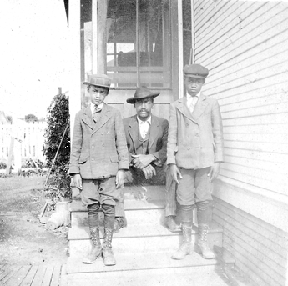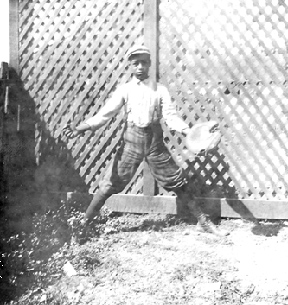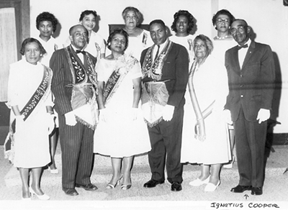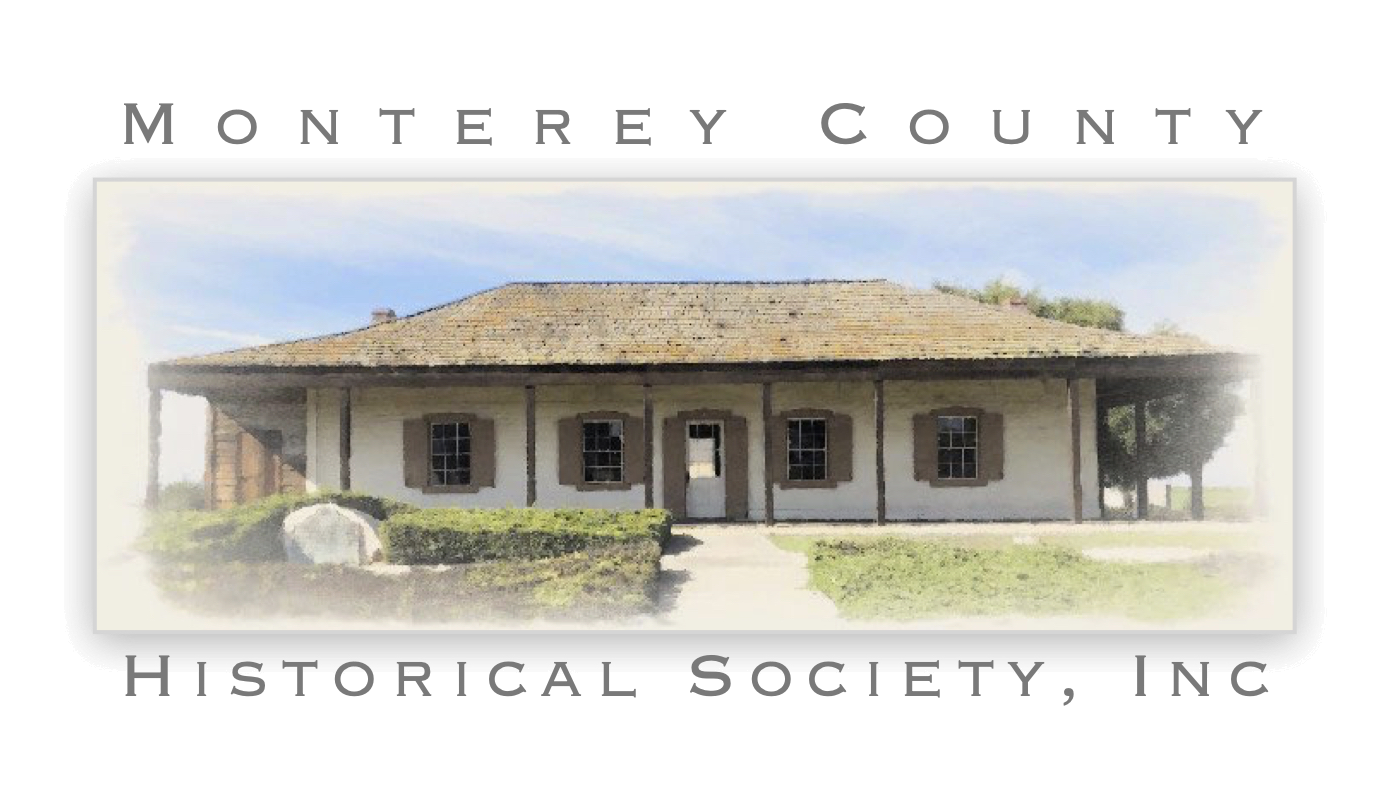The following information was partially adapted from an article by Al Parsons which appeared in the Salinas Californian, April 2, 1977. Additional research has been provided by Mona Gudgel. This article appeared in the February 1997 issue of the Monterey County Historical Society Newsletter.
The roots of Black people in Salinas reach deep. There were Black pioneers almost from the time the first dust streets of the city were laid out, but their numbers were never large. Time has obscured the origins and biographies of most of those settlers. They may as well have been invisible. There was no one to chronicle their lives, like those of the land barons and civic leaders. What little is recalled is stored in the memories of a handful of natives and longtime residents scattered around the city. Like the story tellers Roots author Alex Haley found in Africa, they are the human repositories of the city’s Black history.
The first Black man to come to Salinas appears to have been a slave from Mississippi, brought here and freed by his master Jim Bardin sometime in the late 1850s or early 1860s whom he set up as a blacksmith on Main Street.
It was not the beginning of a vast migration. By the time of Salinas’ first census in 1870, when there were 599 city residents, only two were “colored.” Ten years later in 1880, when there were 1,865 people in Salinas, the census said just eight were Black (five men, three women). Throughout the state there was only a total of 6,018.
In the 19th and early 20th centuries when abject poverty and the bondage of sharecropping in the South kept many Blacks from migrating elsewhere, it was understandable that not many would come all the way west to an uncertain future. There were many former Confederates in this area who would not have welcomed Blacks if they had come. (The intersection of Highway 68 and Hitchcock Road, south of Salinas, was once known as “Confederate Corners” because so many Southerners settled there in the late 1860s).
But even in later years, Salinas did not attract large numbers of Blacks. In 1940, there were only 119 Black Salinas residents. The total reached 312 in 1950. The most likely explanation for the lukewarm attraction lies in the apparent lack of opportunity in a small town. Nearly all the Blacks who came here had jobs on the lower rungs of the job ladder, and many of their children left to find greener pastures.

(Monterey County Historical Society photograph 84.12.22.)
The pioneer Black family most widely remembered in Salinas is the Cooper family, the older members of which were former slaves who settled here sometime in the 1880s. Among them was Mrs. Catherine (Cooper) Gray. She and her sisters and their husbands came to California from Missouri, settling first in Watsonville and then Salinas. With them came Georgeanna Breckenridge, another former slave, who settled here when several Coopers moved to Salinas and was a longtime resident.
It was while in Salinas that Mrs. Gray married a former cook with General George Armstrong Custer’s U.S. Army Cavalry Troops. They bought a home on Natividad Street near Menke Street, with no apparent difficulty. Some time later, Alex Cooper moved his wife and two sons (Ignatius and Leonard) into a house on the same street.
Alex Cooper’s brother also moved to Salinas with a wife and three sons. It was that branch of the Cooper family which novelist John Steinbeck recalled in his 1962 travelogue, Travels with Charley.
The young Ignatius Cooper became a good childhood friend of Steinbeck’s. Ignatius remained a bachelor for many years, and lived with his younger brother Leonard while renting out the home he owned on Maple Street. He married a woman from Seattle during the war years and returned here to live with her. When he decided to move into his Maple Street home, neighbors on the street got up a petition saying they didn’t want him there. He eventually moved in, but not without a shattering impact on him.

(Monterey County Historical Society photograph 84.12.21.)
“It made him very bitter,” says Mrs. Agnes Tebo, who came to Salinas in 1937, joining her father Joe Pradia. The Coopers had mostly white friends in the city “until after he had this experience and found out these whites didn’t care for him as much as he thought,” Mrs. Tebo recalled.
“But we just said to Ignatius, ‘No, you can’t do that. You can’t be bitter.’ I was bitter too for a while, but I said ‘No you just can’t live like that.’”

(Monterey County Historical Society photograph 84.12.14.)
Mrs. Tebo and her husband Louis had reason to be bitter over the run-around they got while trying to buy a home. It took them more than six years.
Agnes Tebo, a highly respected and loved woman of the community, came to Salinas a strikingly lovely woman of 22 in 1937, joining her father Joe Pradia who came to Salinas in 1929. She traveled here from Port Arthur Texas while the country was still limping out of the Great Depression, and good jobs for Blacks in the South were as scarce as water in the desert. Here she went to work as a cook for the Tynan family and found almost no restriction on her movement.
“Here I could make a decent living. I couldn’t in Texas,” she said. “And while it might be hard to find a place to live here, it wasn’t segregated. We were segregated in Texas like you wouldn’t believe.”
Mrs. Tebo found she was the only Black woman in a town with no young Black men. She returned to Port Arthur to marry Louis Tebo and together they returned in 1938. Shortly after that Tebo set up his shoe shine parlor and became an institution at the Jeffery Hotel. So well known and popular did Tebo become that when the hotel was sold to Monterey Savings and Loan the institution kept him on at the insistence of his many friends. Even though you had to “hunt for places to eat and buy a home,” Louis Tebo had no regrets about coming here. “I never thought of going no place else,” he said.

Members of the Eastern Star, Carmelita Chapter, year unknown. Ignatius Cooper is on the far right. Anyone who can identify other individuals in the photograph, provide the year, or can give us any additional information should contact the Society.
(Monterey County Historical Society photograph 84.12.13.)
Tebo at one time probably knew 95 per cent of the city’s population by name, maybe more, and was universally liked. And he appreciated the relationships he had with them as well as employers. “The Jeffrey family was one of the nicest families I ever knew and Monterey Savings and Loan is one of the best organizations I have ever known,” he said. Louis Tebo passed away in December 1992.
Agnes Tebo was one of the founders of the Salinas Branch of the National Association for the Advancement of Colored People. In October 1939 when the Salinas Branch of the NAACP was established there weren’t 50 Black adults in the city, and you had to have 50 people sign a petition to get a NAACP charter. One of the branch’s founders, William Greenwell, took the petition to the County Courthouse where he got enough white citizens to sign. Mrs. Tebo is quoted as saying, “I wish I could remember the names of those brave white men who signed our petition.” You see it wasn’t fashionable to belong to the NAACP.
Today Agnes Tebo is a Charter Member of the Salinas NAACP. She continues to be a strong member of the community giving of herself and her time.

Although Black history of our city is scarce, the Monterey County Historical Society hopes to change all of that. Carol Alleyne, Treasurer of the NAACP, is currently President of the Society and sits on our Cultural Council. Through our combined efforts we are dedicated to gathering as much history as we are able from African-American residents of the community. Their history reaches deep in Salinas and must be recorded for those of us today, as well as future generations.


